Implant-type hearing-aid device wirelessly powered and capable of prompting electric quantity
A hearing aid device and wireless power supply technology, applied in medical science, prosthesis, etc., can solve the problem of difficult feedback of rechargeable battery power, achieve the effects of ensuring safety and stability, controlling coil temperature rise, and reducing structural size
- Summary
- Abstract
- Description
- Claims
- Application Information
AI Technical Summary
Problems solved by technology
Method used
Image
Examples
Embodiment
[0020] figure 1 It is a schematic cross-sectional view of the structure of the human ear, which consists of the outer ear, middle ear and inner ear. The outer ear consists of the pinna 2 and the ear canal 1 . The middle ear is composed of the tympanic membrane 7 , the malleus 3 , the incus 4 and the stapes 5 . The inner ear is mainly composed of the cochlea 6 . For the normal human ear, the sound passes through the ear canal 1 and causes the tympanic membrane 7 to vibrate, driving the ossicular chain (malleus 3, incus 4 and stapes 5) to vibrate, and the mechanical vibration is transmitted to the inner ear, and the vibration of the basilar membrane in the inner ear stimulates the hair cells Nerve impulses are produced to make people hear. Deaf patients can be divided into two categories according to pathology: conductive deafness and sensorineural deafness. Conductive deafness refers to the obstacle of the sound transmission path, and the treatment method is artificial ossi...
PUM
 Login to View More
Login to View More Abstract
Description
Claims
Application Information
 Login to View More
Login to View More - R&D
- Intellectual Property
- Life Sciences
- Materials
- Tech Scout
- Unparalleled Data Quality
- Higher Quality Content
- 60% Fewer Hallucinations
Browse by: Latest US Patents, China's latest patents, Technical Efficacy Thesaurus, Application Domain, Technology Topic, Popular Technical Reports.
© 2025 PatSnap. All rights reserved.Legal|Privacy policy|Modern Slavery Act Transparency Statement|Sitemap|About US| Contact US: help@patsnap.com



